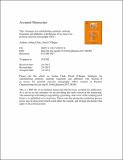Files in this item
Strategies for radiolabelling antibody, antibody fragments and affibodies with fluorine-18 as tracers for positron emission tomography (PET)
Item metadata
| dc.contributor.author | Clark, Joshua | |
| dc.contributor.author | O'Hagan, David | |
| dc.date.accessioned | 2018-07-04T23:34:27Z | |
| dc.date.available | 2018-07-04T23:34:27Z | |
| dc.date.issued | 2017-11 | |
| dc.identifier | 250673993 | |
| dc.identifier | 8332f9c5-0f10-40ae-b456-3f82e0d87361 | |
| dc.identifier | 85028083015 | |
| dc.identifier | 000418727100003 | |
| dc.identifier.citation | Clark , J & O'Hagan , D 2017 , ' Strategies for radiolabelling antibody, antibody fragments and affibodies with fluorine-18 as tracers for positron emission tomography (PET) ' , Journal of Fluorine Chemistry , vol. 203 , pp. 31-46 . https://doi.org/10.1016/j.jfluchem.2017.08.001 | en |
| dc.identifier.issn | 0022-1139 | |
| dc.identifier.other | RIS: urn:CEF62C6666A10A63289C51744EFCB300 | |
| dc.identifier.uri | https://hdl.handle.net/10023/14944 | |
| dc.description.abstract | The use of fluorine-18 as a radionuclide for positron emission tomography (PET) has become increasingly popular over the last two decades and cancer and neurology clinical centres worldwide are increasingly establishing competence in this modality for diagnostic imaging. Progress has been particularly impressive for small molecule pharmaceutical candidates and low molecular weight affinity peptides, where clearance rates of the peptides in the body are compatible with the half-life of fluorine-18 (t1/2 = 110 min). However high molecular weight proteins present challenges as they circulate and clear much more slowly. This review focuses on the methods used to radiolabel antibodies and their derivatives with fluorine-18 as tracers for PET. The very high specificity of these biomolecules for disease indicators at the molecular level makes labelling them attractive, however antibodies can circulate for days within the blood, with slow clearance times due to their high molecular weights, and this is inconsistent with the relatively short half-life of fluorine-18. Thus, lower molecular weight fragments of antibodies present more realistic targets for labelling. This review describes the approaches and protocols which have been successfully used to radiolabel antibodies and particularly antibody fragments with fluorine-18, and highlights this challenging aspect of fluorine-18 labelling for PET imaging. | |
| dc.format.extent | 996551 | |
| dc.language.iso | eng | |
| dc.relation.ispartof | Journal of Fluorine Chemistry | en |
| dc.subject | Fluorine-18 | en |
| dc.subject | Positron emission tomography | en |
| dc.subject | Antibody | en |
| dc.subject | Antibody fragment | en |
| dc.subject | Bioconjugation | en |
| dc.subject | QD Chemistry | en |
| dc.subject | SDG 3 - Good Health and Well-being | en |
| dc.subject.lcc | QD | en |
| dc.title | Strategies for radiolabelling antibody, antibody fragments and affibodies with fluorine-18 as tracers for positron emission tomography (PET) | en |
| dc.type | Journal item | en |
| dc.contributor.institution | University of St Andrews. School of Chemistry | en |
| dc.contributor.institution | University of St Andrews. EaSTCHEM | en |
| dc.contributor.institution | University of St Andrews. Biomedical Sciences Research Complex | en |
| dc.identifier.doi | https://doi.org/10.1016/j.jfluchem.2017.08.001 | |
| dc.description.status | Peer reviewed | en |
| dc.date.embargoedUntil | 2018-07-05 |
This item appears in the following Collection(s)
Items in the St Andrews Research Repository are protected by copyright, with all rights reserved, unless otherwise indicated.

